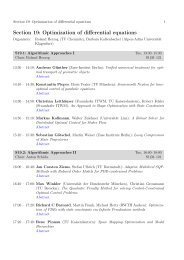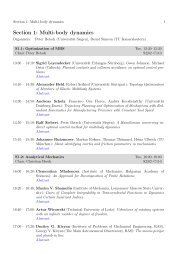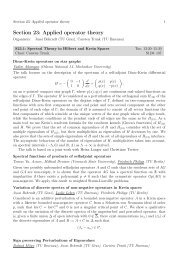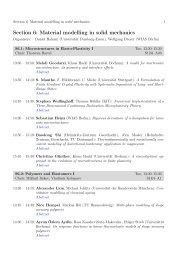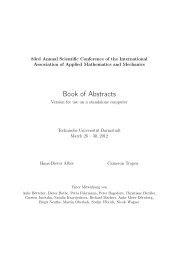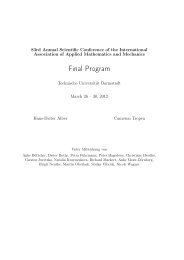Section 6: Material modelling in solid mechanics - GAMM 2012
Section 6: Material modelling in solid mechanics - GAMM 2012
Section 6: Material modelling in solid mechanics - GAMM 2012
Create successful ePaper yourself
Turn your PDF publications into a flip-book with our unique Google optimized e-Paper software.
26 <strong>Section</strong> 6: <strong>Material</strong> <strong>modell<strong>in</strong>g</strong> <strong>in</strong> <strong>solid</strong> <strong>mechanics</strong><br />
Start<strong>in</strong>g with the theoretical concept of Prandtl, who <strong>in</strong>troduced the idea of a harden<strong>in</strong>g<br />
substance <strong>in</strong> a material, and the <strong>in</strong>vestigations of Mughrabi, who established a composite model<br />
for chromium steels, the advanced steels are treated as a composition of at least two cont<strong>in</strong>ua, <strong>in</strong><br />
the sense of the theory of mixture.<br />
Therefore the general balance equations for a mixture will be presented. The example of a<br />
12% chromium steel will be used to illustrate this approach and to derive a material model for<br />
a mixture of two constituents. It will be shown that the model predicts tension-, compression-,<br />
cyclic-creep, uniaxial monotonic tension und low-cycle-fatigue load<strong>in</strong>g <strong>in</strong> a satisfy<strong>in</strong>g manner <strong>in</strong><br />
comparison with experimental results.<br />
Zur Abtragssimulation beim Strömungsschleifen (AFM)<br />
Joachim Schmitt, Stefan Diebels (Universität des Saarlandes)<br />
Im Zuge konkurrenzfähiger Produktionsverfahren werden seit e<strong>in</strong>igen Jahren schwer zugängliche<br />
Kanten im Inneren von komplex aufgebauten Fertigungsteilen (wie beispielsweise die Gehäuse von<br />
E<strong>in</strong>spritzanlagen) mittels des Strömungsschleifens (Abrasive flow mach<strong>in</strong><strong>in</strong>g - AFM) verrundet<br />
bzw. oberflächenvergütet. Dazu wird e<strong>in</strong>e mit Schleifpartikeln versetzte Silikonpaste mehrfach<br />
durch das Bauteil gepresst. Das viskose Verhalten der Paste ist dabei für die effektive Wirkung<br />
dieses Verfahrens sehr wichtig. Beim Überströmen von Kanten steigt die Schergeschw<strong>in</strong>digkeit und<br />
damit auch die Viskosität je nach <strong>Material</strong>modell überproportional an. Die so geänderten Druckund<br />
Geschw<strong>in</strong>digkeitsverhältnisse an der Bauteiloberfläche verändern auch den <strong>Material</strong>abtrag<br />
durch die Schleifpaste.<br />
Im Rahmen dieser Studie werden zunächst die viskosen Eigenschaften der Paste anhand von<br />
Experimenten untersucht und die Modellparameter bestimmt. Im zweiten Teil wird die Paste<br />
h<strong>in</strong>sichtlich ihrer abrasiven Eigenschaften vorgestellt und e<strong>in</strong>e Abschätzung des <strong>Material</strong>abriebs<br />
vorgenommen. E<strong>in</strong> daraus gebildetes e<strong>in</strong>faches Abtragsmodell wird mittels e<strong>in</strong>er FEM-Simulation<br />
an elementaren Bauteilgeometrien umgesetzt und qualitativ überprüft.<br />
<strong>Material</strong> parameter identification us<strong>in</strong>g model reduction to uniaxial tensile tests<br />
Stephan Krämer, Steffen Rothe, Stefan Hartmann (TU Clausthal)<br />
Uniaxial tensile tests are commonly used for material parameter identification. It is also common<br />
to use one-dimensional formulations of a constitutive model to identify the correspond<strong>in</strong>g<br />
material constants, although these material parameters are not necessarily identical to the material<br />
parameters <strong>in</strong> the three-dimensional material model. We present an easy way to reduce a<br />
three-dimensional material rout<strong>in</strong>e to the case of uniaxial tension and to use the reduced form<br />
to derive material parameters us<strong>in</strong>g common trust-region algorithms. With this approach one<br />
is able to use the full three-dimensional model for parameter identification. Instead of us<strong>in</strong>g a<br />
full f<strong>in</strong>ite element software, one is able to use the material driver rout<strong>in</strong>e, which leads to a more<br />
straight forward calculation of material parameters. In this respect, it is shown that the classical<br />
structure of stress algorithms and consistent tangent operators are necessary with<strong>in</strong> the threeto<br />
one-dimensional problem reduction. This procedure is also extendable to further homogeneous<br />
stress- and stra<strong>in</strong>-states.<br />
Systematic representation of the yield criteria for isotropic materials<br />
Vladimir A. Kolupaev (DKI Darmstadt), Holm Altenbach (Universität Magdeburg)<br />
The theory of plasticity operates with different flow criteria of <strong>in</strong>compressible material behavior.<br />
These criteria have hexagonal symmetry <strong>in</strong> the π-plane and do not dist<strong>in</strong>guish between tension<br />
and compression (non-SD-effect). Many tasks <strong>in</strong> the eng<strong>in</strong>eer<strong>in</strong>g practice are treated on the basis



